Unit 8 It must belong to Carla.Section A 1a-1c 说课稿课件(共24张PPT)
文档属性
| 名称 | Unit 8 It must belong to Carla.Section A 1a-1c 说课稿课件(共24张PPT) | 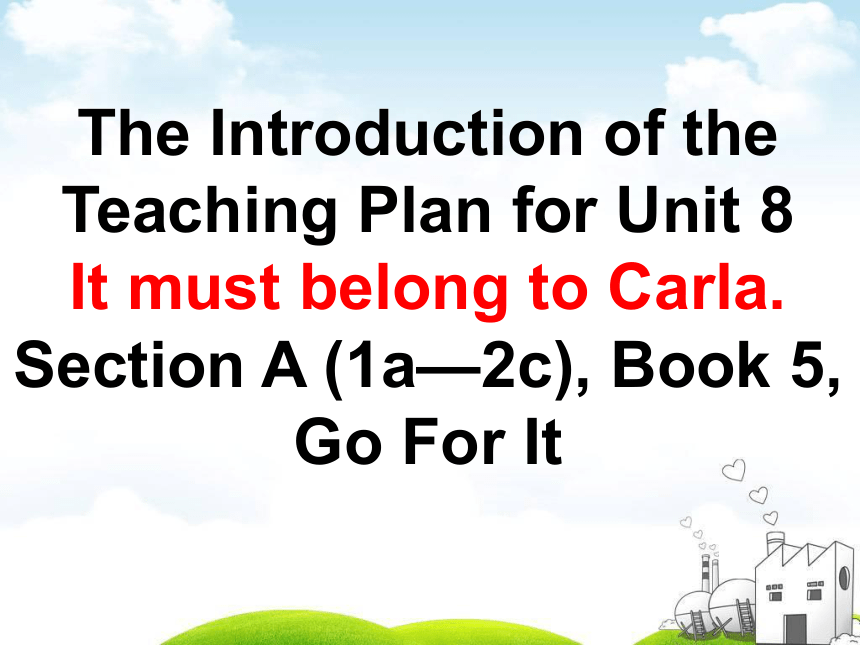 | |
| 格式 | pptx | ||
| 文件大小 | 3.7MB | ||
| 资源类型 | 试卷 | ||
| 版本资源 | 人教新目标(Go for it)版 | ||
| 科目 | 英语 | ||
| 更新时间 | 2021-11-28 21:22:32 | ||
图片预览

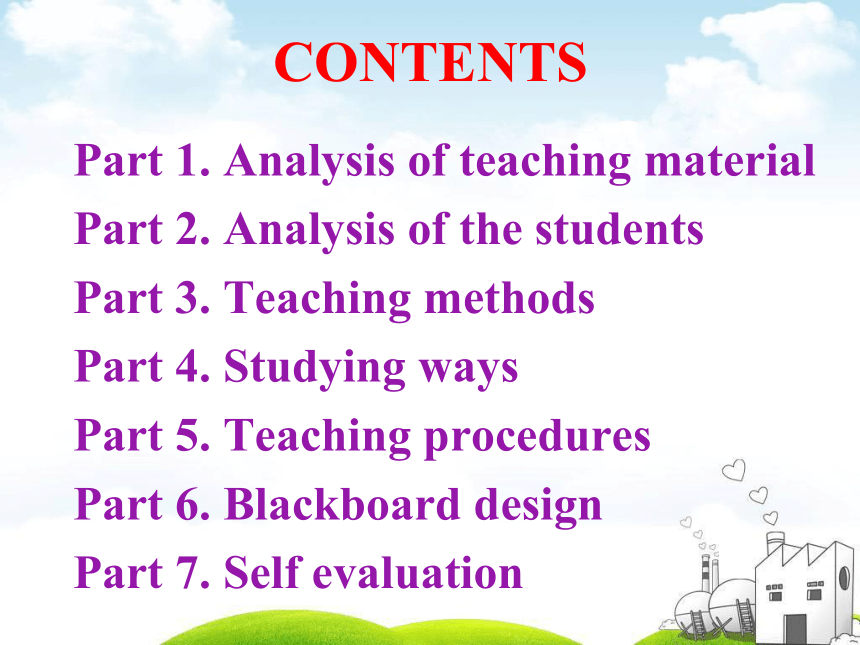
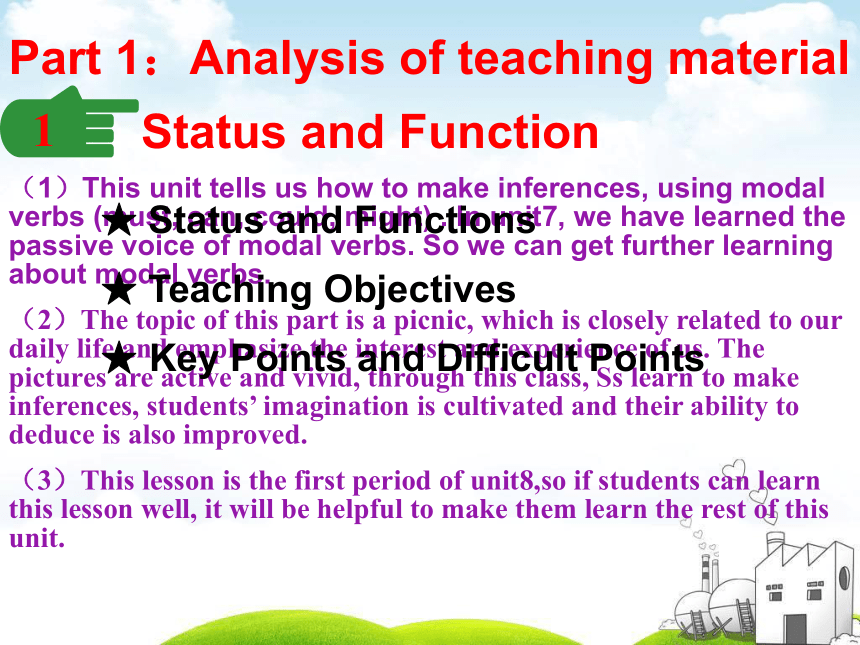
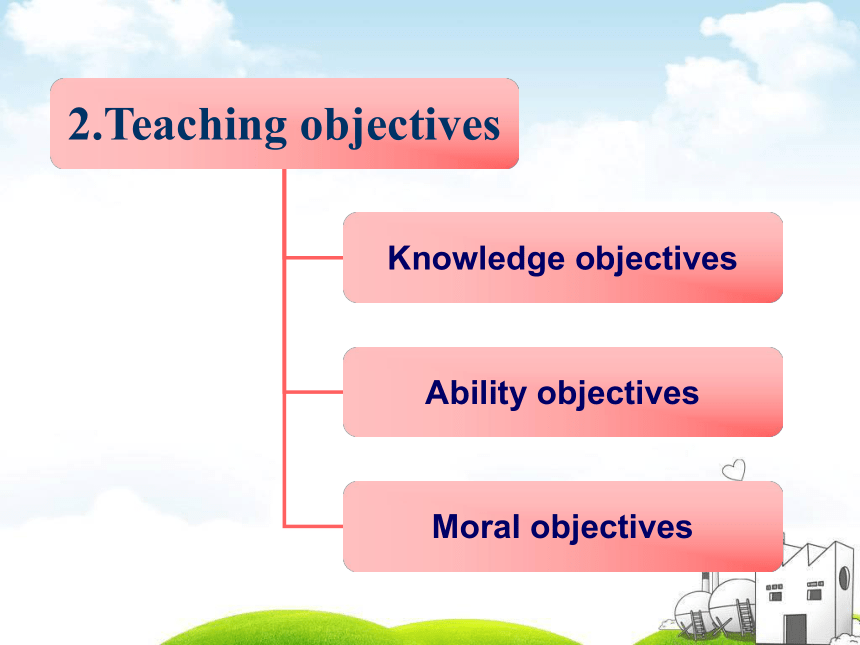
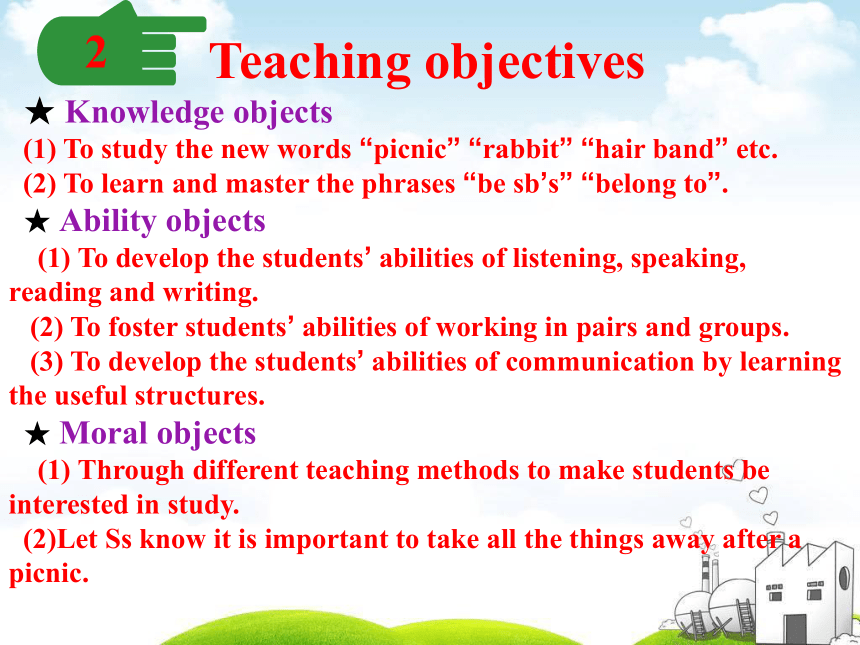
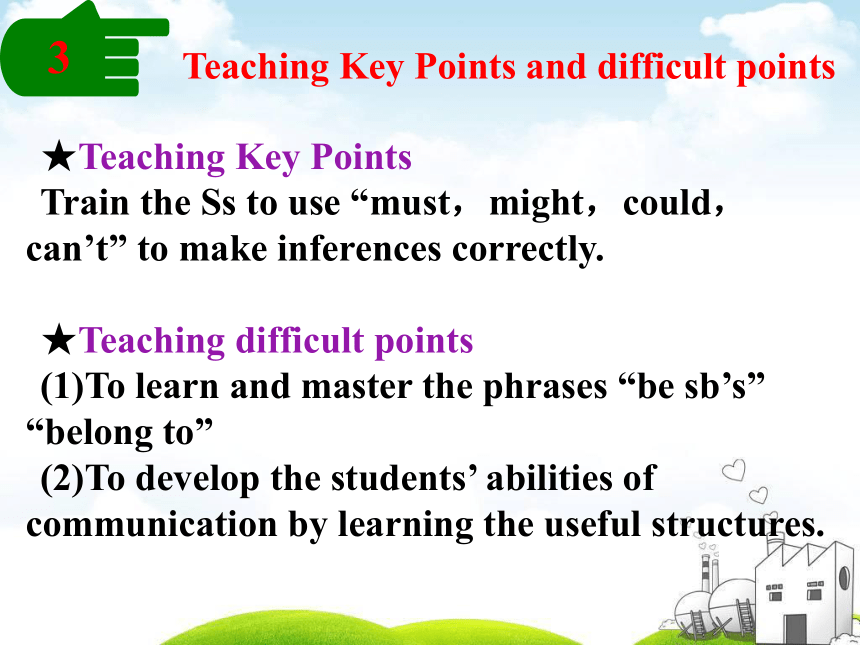
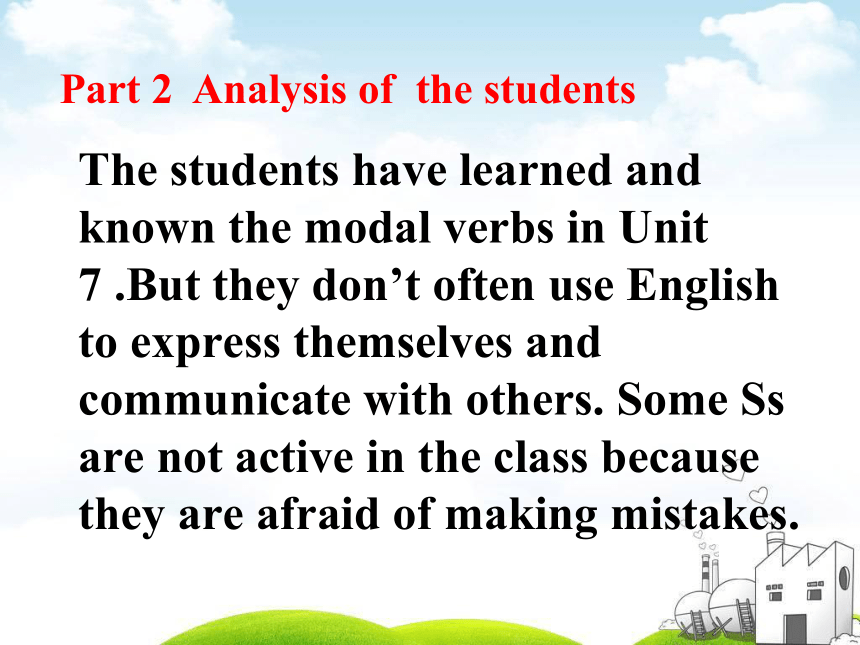
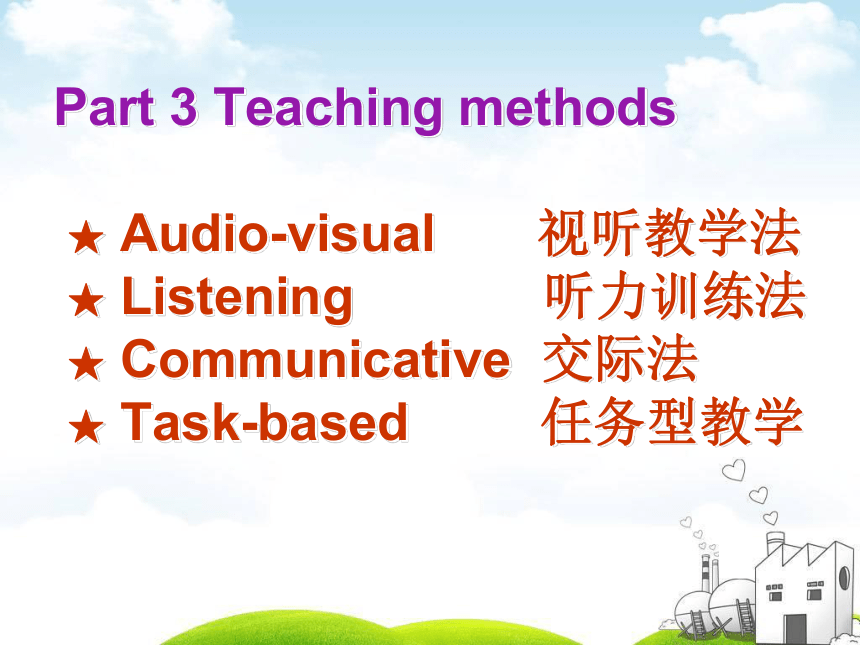
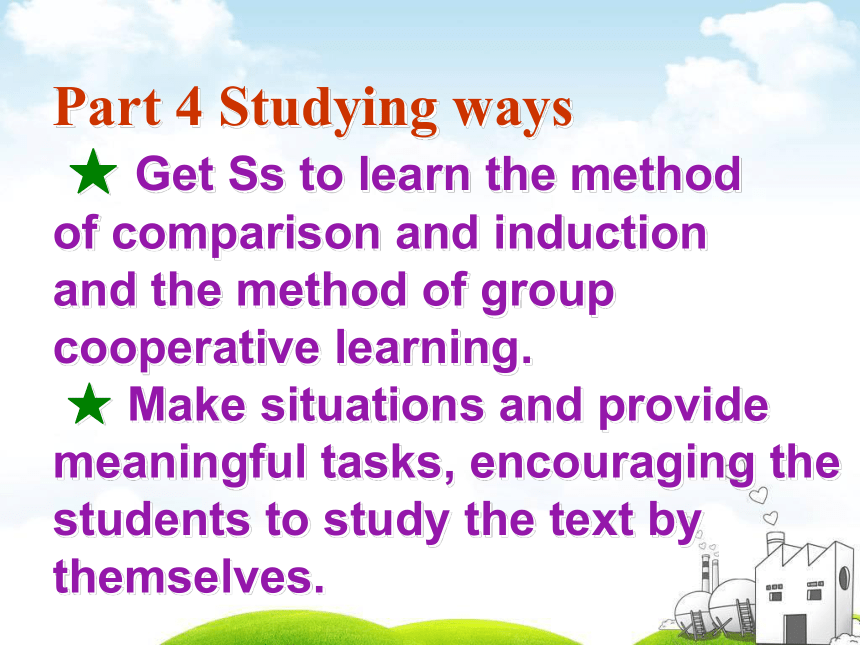
文档简介
(共24张PPT)
The Introduction of the Teaching Plan for Unit 8
It must belong to Carla.
Section A (1a—2c), Book 5, Go For It
CONTENTS
Part 1. Analysis of teaching material
Part 2. Analysis of the students
Part 3. Teaching methods
Part 4. Studying ways
Part 5. Teaching procedures
Part 6. Blackboard design
Part 7. Self evaluation
Part 1:Analysis of teaching material
Status and Function
(1)This unit tells us how to make inferences, using modal verbs (must, can, could, might) . In unit7, we have learned the passive voice of modal verbs. So we can get further learning about modal verbs.
(2)The topic of this part is a picnic, which is closely related to our daily life and emphasize the interest and experience of us. The pictures are active and vivid, through this class, Ss learn to make inferences, students’ imagination is cultivated and their ability to deduce is also improved.
(3)This lesson is the first period of unit8,so if students can learn this lesson well, it will be helpful to make them learn the rest of this unit.
★ Status and Functions
★ Teaching Objectives
★ Key Points and Difficult Points
1
2.Teaching objectives
Knowledge objectives
Ability objectives
Moral objectives
.
★ Knowledge objects
(1) To study the new words “picnic” “rabbit” “hair band” etc.
(2) To learn and master the phrases “be sb’s” “belong to”.
★ Ability objects
(1) To develop the students’ abilities of listening, speaking, reading and writing.
(2) To foster students’ abilities of working in pairs and groups.
(3) To develop the students’ abilities of communication by learning the useful structures.
★ Moral objects
(1) Through different teaching methods to make students be interested in study.
(2)Let Ss know it is important to take all the things away after a picnic.
2
Teaching objectives
★Teaching Key Points
Train the Ss to use “must,might,could,can’t” to make inferences correctly.
★Teaching difficult points
(1)To learn and master the phrases “be sb’s” “belong to”
(2)To develop the students’ abilities of communication by learning the useful structures.
3
Teaching Key Points and difficult points
The students have learned and known the modal verbs in Unit 7 .But they don’t often use English to express themselves and communicate with others. Some Ss are not active in the class because they are afraid of making mistakes.
Part 2 Analysis of the students
Part 3 Teaching methods
★ Audio-visual 视听教学法
★ Listening 听力训练法
★ Communicative 交际法
★ Task-based 任务型教学
Part 4 Studying ways
★ Get Ss to learn the method
of comparison and induction
and the method of group cooperative learning.
★ Make situations and provide meaningful tasks, encouraging the students to study the text by themselves.
Part 5 Teaching procedures
1
Lead-in
2
Presentation
3
Practice
4
Situational practice
5
Listening practice
6
Additional activities
Homework
7
Step1 Lead-in(2m)
Get a book from a student named Liu Li. Then ask “Whose book is this ”
Ss may answer “ It is Liu Li’s.” Then I will say “Yes, it must be Liu Li’s. It must belong to Liu Li.”
In this part, Ss will get a brief and basic understanding of “must be someone’s” and “must belong to someone”.
Purpose:
Step 2 Presentation(2m)
Present the sentences on the Bb. Then teach Ss to read.
After reading, Ss will get a better understanding of target language: “must be someone’s” “must belong to someone”. It will help Ss to use the phrases in the following steps.
Purpose:
Step 3 Practice
(1)Play a video. Ss answer the question “Whose math book is it ” (3m)
★The math book must be Alice’s.
The math book must belong to Alice.
★The math book can’t be Mike’s.
The math book can’t belong to Mike.
Through watching the video and
answering the question, Ss learn to use “must” “can” to make inferences, it’s much easier for Ss to learn and grasp the key points.
Purpose:
(2)Ss read the sentences below and fill in the blanks. (2m)
Belong to
★ It must be Carla’s.
It must belong to Carla.
★ It can’t be Mary’s.
It can’t belong to Mary.
★ It might be Bob’s.
It might belong to Bob .
★ It could be Jane’s.
It could belong to Jane .
This part is added to enhance
the using of modal verbs.
Purpose:
(3)Finish 1a in groups. (2m)
Ss can review the words related to the belongings. It contributes to the listening and speaking practice.
Purpose:
Step 4 Situational Practice
(1) I’d like to create a situation. Many Ss are careless and left their things after a picnic. Think of three persons at the picnic. Let Ss try to make inferences. (3m)
This part is designed as a lead-in to
the listening of 1b.
(2)Pair work(3m)
Ss work in pairs and practice the conversations.
It’s helpful to foster Ss’ conscience of
cooperating with their partners. It can also help to develop Ss’ speaking skills.
Purpose:
Purpose:
Step 5 Listening Practice (4m)
Listen and match the person with the thing. Then make predictions about the reasons. At last, listen and check the answers.
This part will help to develop Ss’
abilities of listening and predicting some information with their experience.
Step 6 Post-listening activity(4m)
Ss work in pairs and practice the conversations.
Ss practice using modal verbs to make
inferences in situations. It helps to improve Ss’ spoken English and communicative abilities.
Purpose:
Purpose:
Step 7 Listening (8m)
(1) Create a situation: I pick up a pink hair band. “Whose hair band is it ”
Let Ss have a discussion.
A: Whose pink hair band is it
B:It must belong to…
It might belong to…
It can’t belong to …
( 2) Listening activities. (2a-2b)
Listen and write down the things in the schoolbag. Then check the answers. (2a)
Listen again and fill in the blanks. (2b)
Through the listening activities, Ss learn to get
key words and useful information to complete
listening tasks. Enough in-put from listening contributes to the following speaking practice.
Purpose:
Step 8 Additional activities
(1) Post-listening activities (3m)
Ss compare the modal verbs and make inductions.
In this way, Ss can tell the differences
these modal verbs. And they can use them
in more suitable ways.
(2)Guessing Game (3m)
Ss are given information little by little. Then they can make inferences.
Ss are interested in games, and will take
an active part in the game. The process of
guessing contributes to enhance their learning of target language.
Purpose:
Purpose:
Step 9 Group Work (5m)
Ss are divided into groups. Each group will get a box. Open the box and deduce whose the belonging it is.
Make a survey
A: Whose… is it
B: It can’t/ might / must be ….’s.
It can’t/ might/ must belong to ….
This part helps Ss to improve their
abilities of writing and speaking.
Name can’t be/belong to might must
My name
Partner 1
Partner 2
Partner 3
Purpose:
Step 10 Homework (1m)
Ss are asked to write a composition about the survey results.
It contributes to foster Ss’ ability to organize a composition. It can also help Ss to review and apply the language points.
Purpose:
Part 6 Blackboard design
In my opinion, the blackboard design can
reflect the teacher’s ability of mastering
the text and leading the students to master the text easily. In this text, I write the key words and the usage of “must be sb’s ”and “belong to sb” on the blackboard in order to tell the students that this is of the importance in this class. I want them to use them correctly and flexibly.
Unit 8 It must belong to Carla.
Key vocabulary Language target
belong to Whose book is this
picnic It must be Liu Li’s.
rabbit It must belong to Liu Li.
hair band must/can’t/might
Purpose:
Part 7 Self evaluation
In order to make the students the real masters in class while the teacher himself acts as director. I designed some activities to arouse the students’ interest of studying .The students can learn the target language easily .Also ,by these activities , I’ve cultivated the students’ spirit of cooperating , trained the students’ skills of listening ,speaking , reading , writing ,improved the students’ ability
of collecting information and dealing with the information. Help the students to form a good habit in life—take away the rubbish after a picnic.
Thanks for Listening!
The Introduction of the Teaching Plan for Unit 8
It must belong to Carla.
Section A (1a—2c), Book 5, Go For It
CONTENTS
Part 1. Analysis of teaching material
Part 2. Analysis of the students
Part 3. Teaching methods
Part 4. Studying ways
Part 5. Teaching procedures
Part 6. Blackboard design
Part 7. Self evaluation
Part 1:Analysis of teaching material
Status and Function
(1)This unit tells us how to make inferences, using modal verbs (must, can, could, might) . In unit7, we have learned the passive voice of modal verbs. So we can get further learning about modal verbs.
(2)The topic of this part is a picnic, which is closely related to our daily life and emphasize the interest and experience of us. The pictures are active and vivid, through this class, Ss learn to make inferences, students’ imagination is cultivated and their ability to deduce is also improved.
(3)This lesson is the first period of unit8,so if students can learn this lesson well, it will be helpful to make them learn the rest of this unit.
★ Status and Functions
★ Teaching Objectives
★ Key Points and Difficult Points
1
2.Teaching objectives
Knowledge objectives
Ability objectives
Moral objectives
.
★ Knowledge objects
(1) To study the new words “picnic” “rabbit” “hair band” etc.
(2) To learn and master the phrases “be sb’s” “belong to”.
★ Ability objects
(1) To develop the students’ abilities of listening, speaking, reading and writing.
(2) To foster students’ abilities of working in pairs and groups.
(3) To develop the students’ abilities of communication by learning the useful structures.
★ Moral objects
(1) Through different teaching methods to make students be interested in study.
(2)Let Ss know it is important to take all the things away after a picnic.
2
Teaching objectives
★Teaching Key Points
Train the Ss to use “must,might,could,can’t” to make inferences correctly.
★Teaching difficult points
(1)To learn and master the phrases “be sb’s” “belong to”
(2)To develop the students’ abilities of communication by learning the useful structures.
3
Teaching Key Points and difficult points
The students have learned and known the modal verbs in Unit 7 .But they don’t often use English to express themselves and communicate with others. Some Ss are not active in the class because they are afraid of making mistakes.
Part 2 Analysis of the students
Part 3 Teaching methods
★ Audio-visual 视听教学法
★ Listening 听力训练法
★ Communicative 交际法
★ Task-based 任务型教学
Part 4 Studying ways
★ Get Ss to learn the method
of comparison and induction
and the method of group cooperative learning.
★ Make situations and provide meaningful tasks, encouraging the students to study the text by themselves.
Part 5 Teaching procedures
1
Lead-in
2
Presentation
3
Practice
4
Situational practice
5
Listening practice
6
Additional activities
Homework
7
Step1 Lead-in(2m)
Get a book from a student named Liu Li. Then ask “Whose book is this ”
Ss may answer “ It is Liu Li’s.” Then I will say “Yes, it must be Liu Li’s. It must belong to Liu Li.”
In this part, Ss will get a brief and basic understanding of “must be someone’s” and “must belong to someone”.
Purpose:
Step 2 Presentation(2m)
Present the sentences on the Bb. Then teach Ss to read.
After reading, Ss will get a better understanding of target language: “must be someone’s” “must belong to someone”. It will help Ss to use the phrases in the following steps.
Purpose:
Step 3 Practice
(1)Play a video. Ss answer the question “Whose math book is it ” (3m)
★The math book must be Alice’s.
The math book must belong to Alice.
★The math book can’t be Mike’s.
The math book can’t belong to Mike.
Through watching the video and
answering the question, Ss learn to use “must” “can” to make inferences, it’s much easier for Ss to learn and grasp the key points.
Purpose:
(2)Ss read the sentences below and fill in the blanks. (2m)
Belong to
★ It must be Carla’s.
It must belong to Carla.
★ It can’t be Mary’s.
It can’t belong to Mary.
★ It might be Bob’s.
It might belong to Bob .
★ It could be Jane’s.
It could belong to Jane .
This part is added to enhance
the using of modal verbs.
Purpose:
(3)Finish 1a in groups. (2m)
Ss can review the words related to the belongings. It contributes to the listening and speaking practice.
Purpose:
Step 4 Situational Practice
(1) I’d like to create a situation. Many Ss are careless and left their things after a picnic. Think of three persons at the picnic. Let Ss try to make inferences. (3m)
This part is designed as a lead-in to
the listening of 1b.
(2)Pair work(3m)
Ss work in pairs and practice the conversations.
It’s helpful to foster Ss’ conscience of
cooperating with their partners. It can also help to develop Ss’ speaking skills.
Purpose:
Purpose:
Step 5 Listening Practice (4m)
Listen and match the person with the thing. Then make predictions about the reasons. At last, listen and check the answers.
This part will help to develop Ss’
abilities of listening and predicting some information with their experience.
Step 6 Post-listening activity(4m)
Ss work in pairs and practice the conversations.
Ss practice using modal verbs to make
inferences in situations. It helps to improve Ss’ spoken English and communicative abilities.
Purpose:
Purpose:
Step 7 Listening (8m)
(1) Create a situation: I pick up a pink hair band. “Whose hair band is it ”
Let Ss have a discussion.
A: Whose pink hair band is it
B:It must belong to…
It might belong to…
It can’t belong to …
( 2) Listening activities. (2a-2b)
Listen and write down the things in the schoolbag. Then check the answers. (2a)
Listen again and fill in the blanks. (2b)
Through the listening activities, Ss learn to get
key words and useful information to complete
listening tasks. Enough in-put from listening contributes to the following speaking practice.
Purpose:
Step 8 Additional activities
(1) Post-listening activities (3m)
Ss compare the modal verbs and make inductions.
In this way, Ss can tell the differences
these modal verbs. And they can use them
in more suitable ways.
(2)Guessing Game (3m)
Ss are given information little by little. Then they can make inferences.
Ss are interested in games, and will take
an active part in the game. The process of
guessing contributes to enhance their learning of target language.
Purpose:
Purpose:
Step 9 Group Work (5m)
Ss are divided into groups. Each group will get a box. Open the box and deduce whose the belonging it is.
Make a survey
A: Whose… is it
B: It can’t/ might / must be ….’s.
It can’t/ might/ must belong to ….
This part helps Ss to improve their
abilities of writing and speaking.
Name can’t be/belong to might must
My name
Partner 1
Partner 2
Partner 3
Purpose:
Step 10 Homework (1m)
Ss are asked to write a composition about the survey results.
It contributes to foster Ss’ ability to organize a composition. It can also help Ss to review and apply the language points.
Purpose:
Part 6 Blackboard design
In my opinion, the blackboard design can
reflect the teacher’s ability of mastering
the text and leading the students to master the text easily. In this text, I write the key words and the usage of “must be sb’s ”and “belong to sb” on the blackboard in order to tell the students that this is of the importance in this class. I want them to use them correctly and flexibly.
Unit 8 It must belong to Carla.
Key vocabulary Language target
belong to Whose book is this
picnic It must be Liu Li’s.
rabbit It must belong to Liu Li.
hair band must/can’t/might
Purpose:
Part 7 Self evaluation
In order to make the students the real masters in class while the teacher himself acts as director. I designed some activities to arouse the students’ interest of studying .The students can learn the target language easily .Also ,by these activities , I’ve cultivated the students’ spirit of cooperating , trained the students’ skills of listening ,speaking , reading , writing ,improved the students’ ability
of collecting information and dealing with the information. Help the students to form a good habit in life—take away the rubbish after a picnic.
Thanks for Listening!
同课章节目录
- Unit 1 How can we become good learners.
- Section A
- Section B
- Unit 2 I think that mooncakes are delicious!
- Section A
- Section B
- Unit 3 Could you please tell me where the restroom
- Section A
- Section B
- Unit 4 I used to be afraid of the dark.
- Section A
- Section B
- Unit 5 What are the shirts made of?
- Section A
- Section B
- Review of Units 1-5
- Unit 6 When was it invented?
- Section A
- Section B
- Unit 7 Teenagers should be allowed to choose their
- Section A
- Section B
- Unit 8 It must belong to Carla.
- Section A
- Section B
- Unit 9 I like music that I can dance to.
- Section A
- Section B
- Unit 10 You're supposed to shake hands.
- Section A
- Section B
- Review of Units 6-10
- Unit 11 Sad movies make me cry.
- Section A
- Section B
- Unit 12 Life is full of the unexpected
- Section A
- Section B
- Unit 13 We're trying to save the earth!
- Section A
- Section B
- Unit 14 I remember meeting all of you in Grade 7.
- Section A
- Section B
- Review of Units 11-14
